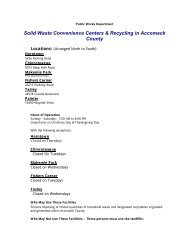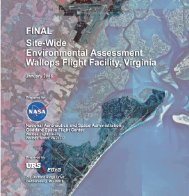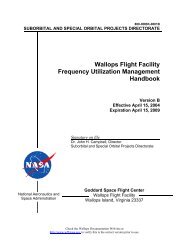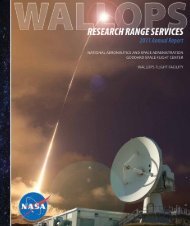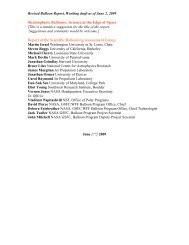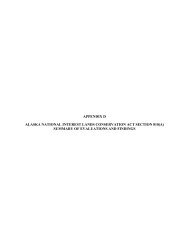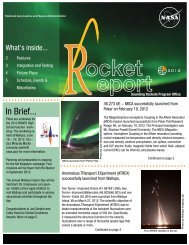Alternative Energy Draft EA - NASA Visitor Center at Wallops Flight ...
Alternative Energy Draft EA - NASA Visitor Center at Wallops Flight ...
Alternative Energy Draft EA - NASA Visitor Center at Wallops Flight ...
You also want an ePaper? Increase the reach of your titles
YUMPU automatically turns print PDFs into web optimized ePapers that Google loves.
Executive Summary<br />
kW wind turbines would be installed near the WFF <strong>Visitor</strong> <strong>Center</strong>, and a second one would be<br />
installed near the security guard st<strong>at</strong>ion <strong>at</strong> the Mainland. The loc<strong>at</strong>ions of the remaining three<br />
residential-scale wind turbines are unknown <strong>at</strong> this time, but would be placed within the areas<br />
th<strong>at</strong> <strong>NASA</strong> has identified as potential suitable loc<strong>at</strong>ions <strong>at</strong> WFF. The residential-scale turbines<br />
would not contribute much to the percent of energy gener<strong>at</strong>ed from renewable sources <strong>at</strong> WFF<br />
because of their small power output; their primary purpose would be to provide outreach and<br />
educ<strong>at</strong>ion to WFF employees and the public about wind energy.<br />
New access roads would be constructed to each utility-scale wind turbine. Underground power<br />
collection lines would be built to interconnect each wind turbine to the existing <strong>Wallops</strong> Island<br />
electrical distribution system. These power lines would be installed by directional drilling, a<br />
trenchless method, to avoid affecting wetlands. Previously disturbed areas, including the cleared<br />
area east of the U.S. Navy V-10/V-20 complex, would be used for staging of equipment and<br />
m<strong>at</strong>erials for the utility-scale turbines, and for construction vehicle parking. The construction<br />
period for the two utility-scale wind turbines would be approxim<strong>at</strong>ely 6 months.<br />
The residential-scale wind turbines would be constructed with a setback distance of 30 meters<br />
(100 feet) from existing towers, buildings, and trees. No transformers or interconnection<br />
switchgear would be needed.<br />
<strong>Altern<strong>at</strong>ive</strong> One<br />
Under <strong>Altern<strong>at</strong>ive</strong> One, <strong>NASA</strong> would construct one utility-scale wind turbine on <strong>Wallops</strong> Island<br />
th<strong>at</strong> would be capable of gener<strong>at</strong>ing 5 GWh of electricity per year. The single 2.0 MW wind<br />
turbine would be loc<strong>at</strong>ed west of the U.S. Navy V-10/V-20 complex in the same loc<strong>at</strong>ion as the<br />
southern wind turbine under the Proposed Action. The footprint, work space, and staging areas<br />
would be the same as described under the Proposed Action, but the construction period would be<br />
approxim<strong>at</strong>ely 4 months. <strong>NASA</strong> would also install up to five 2.4 kW wind turbines <strong>at</strong> the Main<br />
Base and Mainland as described under the Proposed Action <strong>Altern<strong>at</strong>ive</strong>.<br />
In addition to the wind turbines, <strong>NASA</strong> would install a system of solar panels <strong>at</strong> <strong>Wallops</strong> Main<br />
Base th<strong>at</strong> would be capable of gener<strong>at</strong>ing up to 5 GWh/year (the equivalent of one utility-scale<br />
wind turbine). Approxim<strong>at</strong>ely 19,000-square-meter (15-square-foot) solar panels, equaling an<br />
area of approxim<strong>at</strong>ely 3 hectares (7.5 acres), would be needed to meet this power gener<strong>at</strong>ing<br />
capability. Panel spacing requirements (to avoid shading and allow maintenance) would increase<br />
the overall required land area dedic<strong>at</strong>ed to solar panels to approxim<strong>at</strong>ely 16 hectares (40 acres).<br />
The power gener<strong>at</strong>ed by the solar panels would be connected via underground transmission lines<br />
to a set of switchgear th<strong>at</strong> would be enclosed in a small 5-meter by 6-meter (16-foot by 20-foot)<br />
pre-fabric<strong>at</strong>ed building. Solar panels would be installed in open, grassy areas of <strong>Wallops</strong> Main<br />
Base. The install<strong>at</strong>ion period for the solar panels would be approxim<strong>at</strong>ely 2 months.<br />
<strong>Altern<strong>at</strong>ive</strong> Two<br />
<strong>NASA</strong> would install up to five 2.4 kW wind turbines <strong>at</strong> the Main Base and Mainland as<br />
described under the Proposed Action <strong>Altern<strong>at</strong>ive</strong>. <strong>Altern<strong>at</strong>ive</strong> Two would also consist of<br />
installing a system of solar panels <strong>at</strong> <strong>Wallops</strong> Main Base th<strong>at</strong> would be capable of gener<strong>at</strong>ing 10<br />
GWh/year of power. To produce this amount of energy, WFF would install approxim<strong>at</strong>ely<br />
38,000-square-meter (15-square-foot) solar panels th<strong>at</strong> would equal an area of approxim<strong>at</strong>ely 6<br />
hectares (15 acres). Panel spacing requirements (to avoid shading and allow maintenance) would<br />
ii




